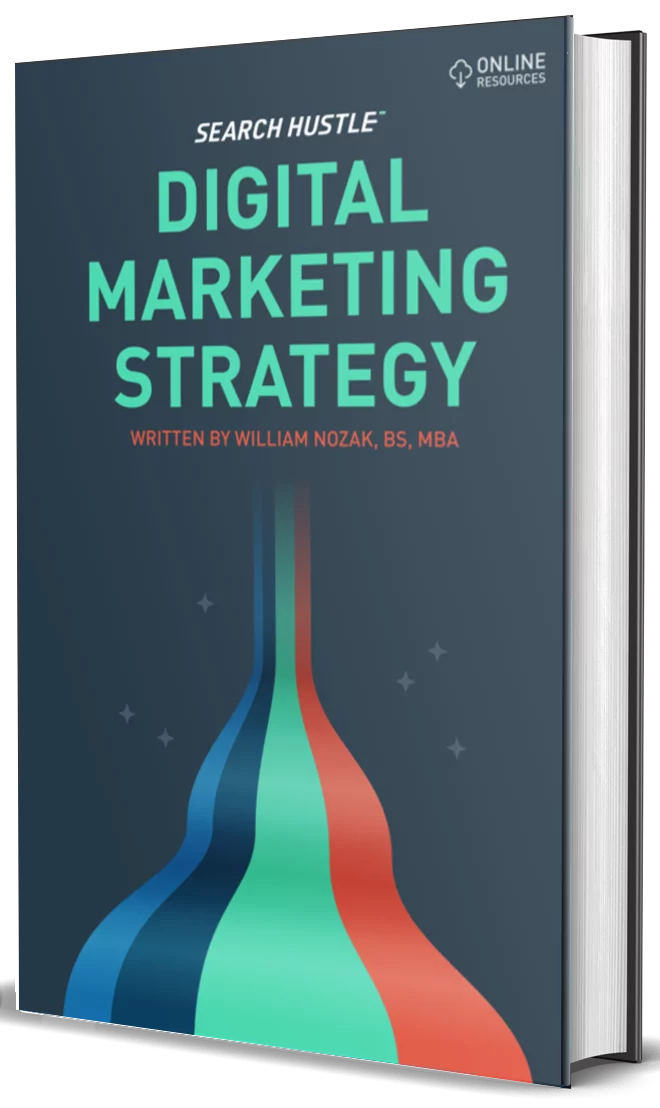Optimize Meta Titles and Descriptions
Learn all about how to optimize meta titles and meta descriptions.
An excellent way to get moved up in the SERPs is to understand how to properly optimize a website’s meta titles and descriptions.
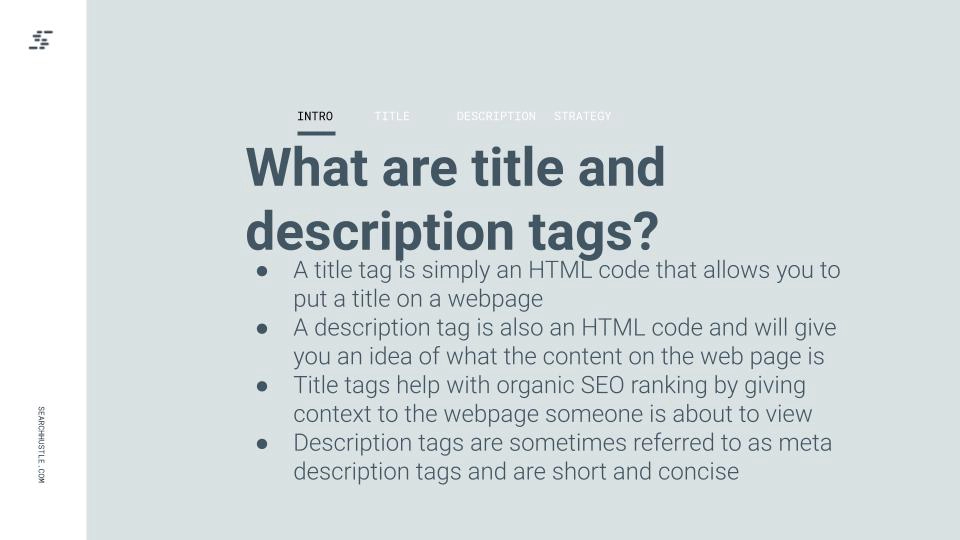
HTML Elements
Don’t forget to view the source code of the website. Optimizing these key elements will help organize the site’s content while making it easier for readers to find what they’re looking for. Additionally, it will help search engines understand the context of the content and rank it accordingly.
These on-page optimizations are moderately technical and could be classified as technical SEO. The different HTML elements that should be reviewed are:
- Page titles – Otherwise known as title tags, page titles are one of the more important SEO elements. The page title informs visitors and bots alike what content is on a page.
- Headers – The most common headers on a webpage are H1, H2, and H3s. Using these tags will organize the content and inform the bots what part of the content is relevant based on the user’s search intent.
- Meta descriptions – Short descriptions that give information about the page’s content. The meta description appears under the title in search results. Keep the meta description between 150-160 characters, and include the focus keyword for that page.
- Image alt-text – Think of image alt-text as SEO for the image. It can help the search engine understand what the image is. Additionally, should an image fail to load, or where a screen reader is being used, the alt-text will appear or be read aloud. Keep the image alt-text under 125 characters, use the keyword, and be specific when describing the image.
- Structured markup – Marking up the website source code can help search engines find and rank the content. Structured markup is vital for Featured Snippets.
- HTML sitemap – This acts like a blueprint for your site. It helps a search engine find and crawl a website so the content can be indexed. Sitemaps also indicate the most important pages on a site.
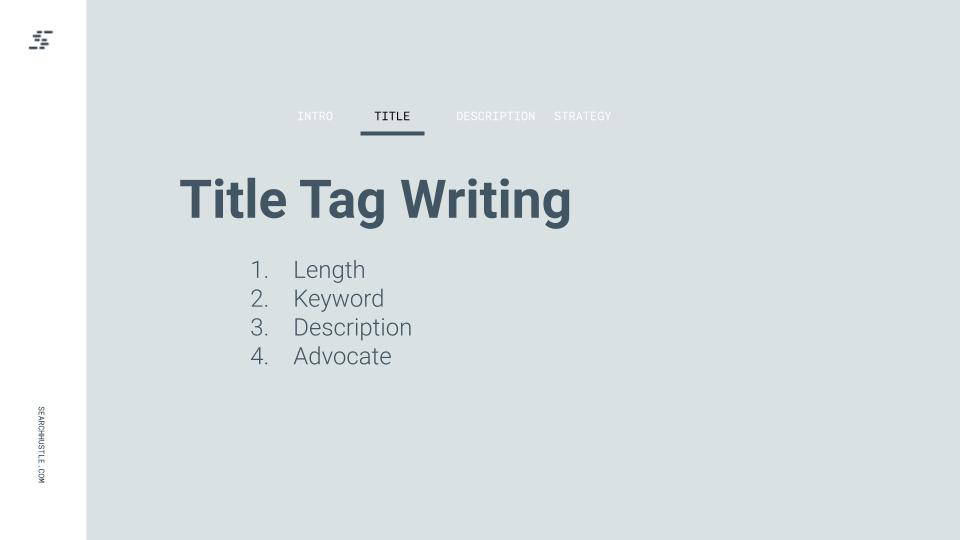
Title Tag Tag
A title tag is simply an HTML code that allows you to put a title on a web page. This helps with your organic ranking by giving context to a web page. Content without context isn’t helpful, so the algorithm will reward pages with title tags.
Many experts believe the title tag is one of the most important aspects. So, if you’re wondering how important title tags are, they’re an essential element you must include on every SEO-hungry page.
Optimizing title tags is an efficient and effective way to improve SERP rankings. Every title selection should be based on keyword research and accurately represent the page’s content. Each web browser has different acceptable lengths for the title tag, but Google is the most important. Currently, we aim to keep title tags under 60 characters.
There are many SEO tools that give you access to title tag tools. They allow you to test different titles and see how they will be displayed in the SERPs. In the real world, we’ve found that going over the “recommended pixel length” isn’t a deal-breaker and, in some instances, can be advantageous. So, while only a certain amount of characters are visible on certain viewports, the bots still read this information. With the enormous number of viewports, it’s difficult to predict what character length will be served. Going below the recommended pixel length leaves a title looking short and incomplete.
1. Length
A vital component of a title tag is the length. Always remember there is a maximum of 50-60 characters per tag, so plan accordingly. Take full advantage of these characters – every letter should be intentional. Google AI updates have recently started favoring tags under 60 characters – so be mindful of those trends as they evolve.
2. Keyword
As one might expect, keywords are essential, even in meta tags. Use the primary keyword or a variation of it from the core page content in the tag. Be careful not to overdo it. Keyword stuffing isn’t going to help the page rank any higher on the SERP. These days, this type of behavior is a waste of time.
The recommended key phrase density is still 1 to 3%. If there is a keyword that is the foundational word in that phrase, it could be 3 to 5%. Between synonyms, alternate phrasing, and semantic terms (golf clubs, sticks, nine irons, etc.), you could target 5 to 10% keyword density.
3. Descriptive
The purpose of the title tag is to convince the reader that what they need is on that page. The more accurate and concise the tag, the better you will match the page against a user’s intent which should bear out in a higher click-through rate. Not to mention this is a rankable element.
4. Advocate
While space is limited, if possible, make a case for why people should view the page. This isn’t just a title; more a reason why someone should check out the web page from the SERPs. Instead of writing a simple title, view it as an effective tool to draw in interested readers. Check out what your competitors are doing, and try to make something that makes yours stand out.
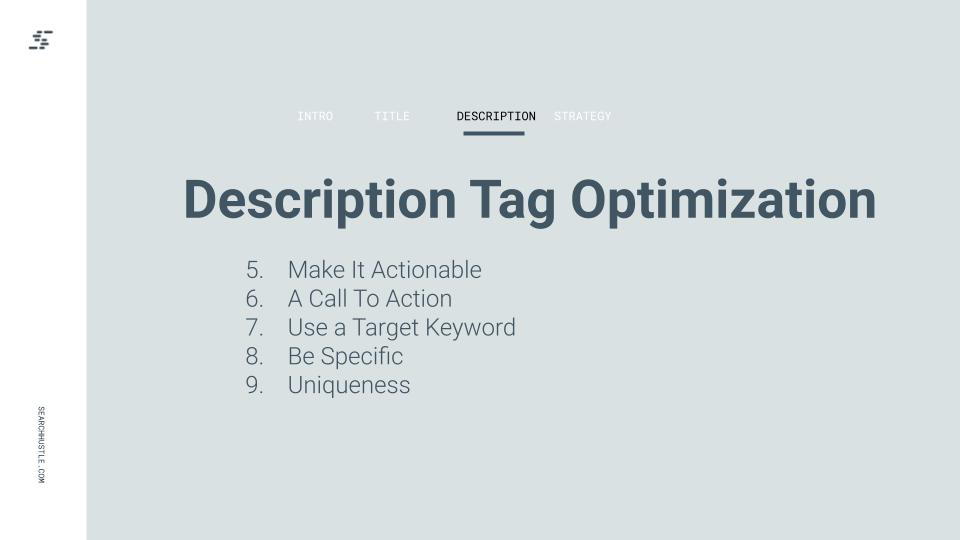
Meta Description Tag
A description tag is also an HTML code, but it doesn’t have anything to do with the title. Instead, a meta description will indicate what is contained within the page’s content.
Remember, Google typically shows the meta title and meta description tags in search results, making it more likely to be read. The title and description should be different from each other. Always double-check what Google considers best practice regarding length, as it changes over time.
In many regards, meta descriptions can be as important as the page title. Although they aren’t a direct ranking factor, they’re still an excellent tool for improving click-through rate (CTR). This text is displayed in the SERPs, just below the meta title. If a meta description isn’t designated, the bots will usually automatically generate a description of the page based on its content. Setting your description gives you more control to choose what searchers see and concisely summarize why they should click your page. It should be noted, setting it does not guarantee that Google will use it, which is pretty much the case with everything.
Actionable
Avoid abstract descriptions. Err on the side of actionable descriptions. This means there has to be a practical reason for viewing the content. It needs to be something that can be acted upon.
2. A Call To Action
Don’t expect readers to do the work of figuring out how to act on the content, including a call to action. Challenge the readers to take steps to use the content, including how it could benefit them. The clearer and more imperative the call to action is, the more successful it is going to be.
3. Target Keyword Utilization
As with the content, include a target keyword in the web page’s meta description. This will help the algorithm understand the importance and placement of the page. The more specific and popular a keyword or phrase is, the more impactful it will be.
4. Specific
Every meta description and tag you use needs to be unique to that page. Never reuse a description or tag; that can work against you and negatively impact rankings. The more unique, the better; it will help the user and bots know exactly what is on that page.
5. Unique
Each and every meta description and tag used needs to be unique to that page. Never reuse a description or tag, as that can end up working against the ranking. The more unique the better, as it will help the algorithm rank the page specifically.
6. Cannibalization Avoidance
We want to ensure that pages do not compete against each other for the same topics or keywords. Typically, this is addressed in your website’s planning and tracking phases, but it’s something always to keep front of mind.
As a website ages and you add new content, you should ensure the fresh content does not compete with existing content.
Both the title tag and meta description are hugely important. No matter how high a page ranks, people won’t click on it if the page below has a title and description that is more intriguing; or if it looks like the next page is more relevant to their search.
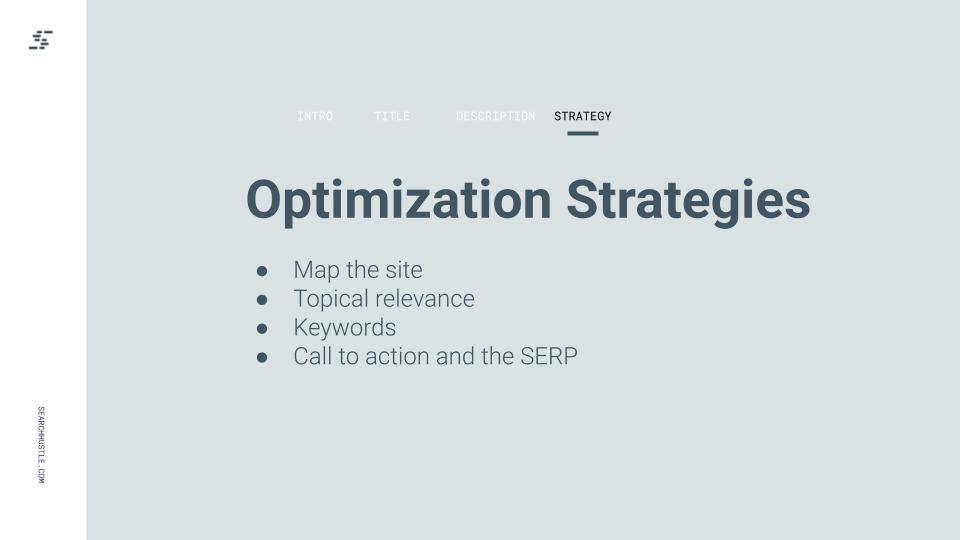
Optimization Strategies - laying the groundwork for a holistic SEO strategy
When it comes to writing successful, usable tags and descriptions, there are some optimization strategies that can go further. These are optimizations that can be made to any description or title tag to give you an edge over your competition.
1. Map the Site
It can be difficult to keep track of every page on a website, and failing to do so has serious negative impacts. Make sure to map out your site, and understand where each page fits into the overall narrative you are building. This will help make the title tag more unique and contextual.
2. Topical Relevance
When writing a title tag or a meta description, always consider the topical relevance on each individual page. Your title tag or description will work better if it is contextual, topical, and is relevant to the content, as it will draw viewers in from the SERP page.
3. Keywords
When it comes to on-page SEO, there is always a focus on keyword usage. Make sure the same keyword that is targeted in the content is used in the title tag and the meta description. This should be a commonly searched for keyword or phrase in order to draw the most attention and search results.
4. Call To Action and the SERP
The title tag and meta description are going to show up on the SERP. When someone searches using the keyword, the results will bring up both of these, with the title tag being the blue writing. This means that having a call to action that draws them in located in both description and title, is vital to capturing more views.
Titles and Descriptions
No matter what else happens, remember the importance of having a strong and unique meta title and meta description. These are vital components to any successful SEO strategy, almost as important as the content itself. Eyes will not be drawn to the content if the title tag and description aren’t used correctly.
Optimization occurs at every step of the process, from creating the title tag and writing the description, to finding the keyword and a proper call to action. No element of this process can be overlooked without the entire effort struggling or ultimately failing to produce the results needed.
Make sure that the unique title tags and descriptions used on each webpage are made with as much quality as possible.

Ready to Take Your Search Hustle Further?


